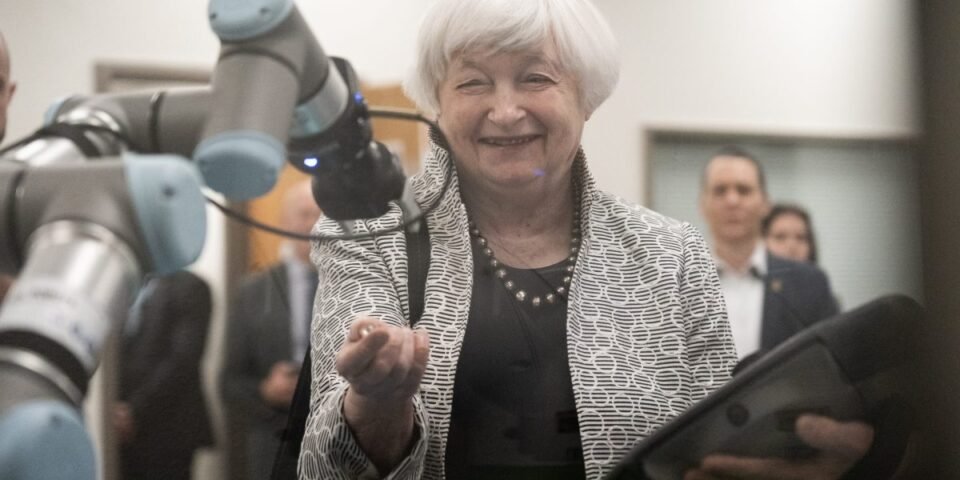Labor productivity growth in the United States, Canada, and advanced economies in Western Europe and Asia, has been dismal for almost a generation, hovering around 1% a year. Is this lackluster performance all we can expect for the next generation?
It doesn’t have to be. In fact, to deal with rising inflation, wobbly balance sheets, aging populations, and the net-zero transition, it is urgent to do better. Recent research by the McKinsey Global Institute (MGI) argues that by doing two things—boosting investment and accelerating a broader digital transition—current drags on productivity growth can be removed.
What happened
Productivity in advanced economies had been deteriorating gradually before the 2008 global financial crisis (GFC), falling from an average of 2.2% a year in 1997-2002 to 1.6% in 2002-2007.
The GFC was an inflection point: Productivity growth fell abruptly to about 1%—where it has been stuck ever since. Among the many reasons for this, two explain almost all of the decline: a secular decline in investment and the end of two manufacturing-related productivity waves.
In terms of investment, a series of crises—the dot-com crash in 2001, the GFC in 2008, and the pandemic in 2020, depressed growth in the ratio of capital invested per worker. From 1997 to 2019, capital investment in tangibles like machines and buildings fell from 22 to 14% of gross value added in the United States and from 25 to 17% in Europe. Investment in intangibles, such as software, grew over that period, but not nearly enough to make up the difference. Additionally, after the GFC, net investment—that is, after accounting for the degradation of capital stock—as a share of GDP fell by half in both the U.S. and Western Europe and has never fully recovered.
In terms of manufacturing, in the 1990s and early 2000s, Moore’s law (the doubling of the number of transistors in a microchip every two years) sharply accelerated productivity growth in electronics and computers. However, that effect ebbed as features like battery life became more important. The second productivity wave came with the rise of China and other emerging economies, in the form of restructuring and offshoring lifting productivity in advanced economies. By the mid to late-2000s, both waves had receded.
The good news is that investment does not have to stay depressed and that digital technologies and artificial intelligence could boost productivity the same way the two manufacturing waves did.
Investment
The U.S. and Europe capital investment gap, compared to the years before the GFC, amounts to 2 to 3% of GDP—approximately $1 trillion a year. MGI estimates that returning to that level could add 0.7 percentage points to productivity growth. Of course, many barriers, such as regulation and skills gaps, can stand in the way of greater investment. But when there is robust demand and tight labor markets—signals that present a clear case for capacity expansion and productivity-enhancing automation—business will respond.
In the U.S., this may help explain why business investment is pointing up, if only slightly—about 0.3 percentage points higher than in the pre-pandemic decade. Indeed, U.S. productivity growth has spiked of late—rising near or above 3% on an annualized basis for three consecutive quarters before moving closer to long-run averages in Q1 2024.
Western Europe has more work to do: The war on Ukraine and subsequent energy shock have reduced consumer purchasing power and competitiveness while adding uncertainty. Fiscal policy has been less generous in stimulating the economy than in the U.S. The region will have to restore competitiveness and create a stronger macro-environment to unleash investment.
Digital and AI
Productivity growth related to digital technology and artificial intelligence (AI) has been anticipated for a long time—and it’s far from over.
The information and communication technology (ICT) sector, which drives digital transformation, has contributed almost half a percentage point to productivity growth over the past two decades in the U.S. However, other sectors have found it difficult to convert their digital investment into measurable productivity advances. AI might be the answer. MGI research estimates that greater deployment of digital and AI capabilities could add 0.5 to 1.0 percentage points to annual productivity growth in advanced economies. Generative artificial intelligence could add another 0.5 percent.
In the U.S., the investments needed to make that possible could be underway. The so-called magnificent seven alone have invested $200 billion in research and development, according to McKinsey analysis based on S&P Global, in 2023 (about half the figure of all such R&D investment, public and private, in the European Union), plus a similar amount in capital expenditure.
Again, Europe clearly has more work to do. One issue is that tech ecosystems in Europe are still nascent. More could be done to nurture them, such as public innovation procurement in areas from health care to defense. Another is that fragmentation stands in the way of firms reaching the critical scale to undertake bold technology and digital investments. Cross-border consolidation and the introduction of common European business rules could help. And restructuring of pension funds could re-allocate more funds to venture capital.
While the price of productivity stagnation is invisible, it is high. By investing to regain pre-GFC productivity growth, advanced economies stand to gain between $1,500 and $8,000 in incremental GDP per capita by 2030. By stepping up the pace of investment and technological innovation, it is possible to leave the era of stagnation behind. It is time to step up.
Chris Bradley and Olivia White are senior partners in McKinsey & Company’s Sydney and San Francisco offices and directors of the McKinsey Global Institute. Jan Mischke is a McKinsey Global Institute partner in Zurich.
More must-read commentary published by Fortune:
The opinions expressed in Fortune.com commentary pieces are solely the views of their authors and do not necessarily reflect the opinions and beliefs of Fortune.

